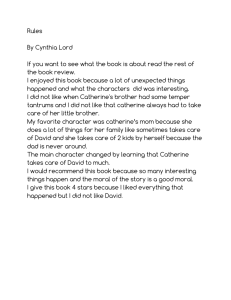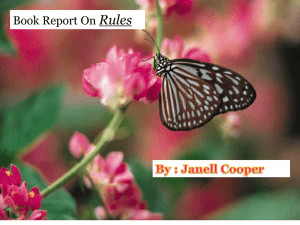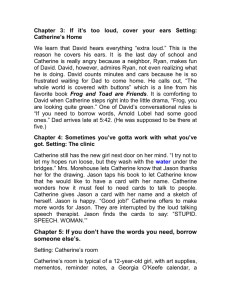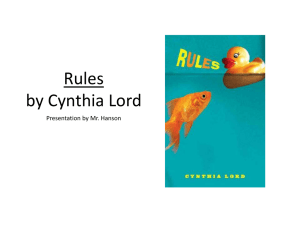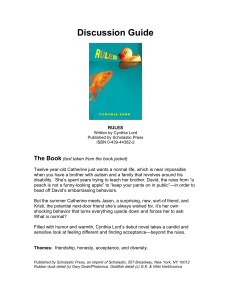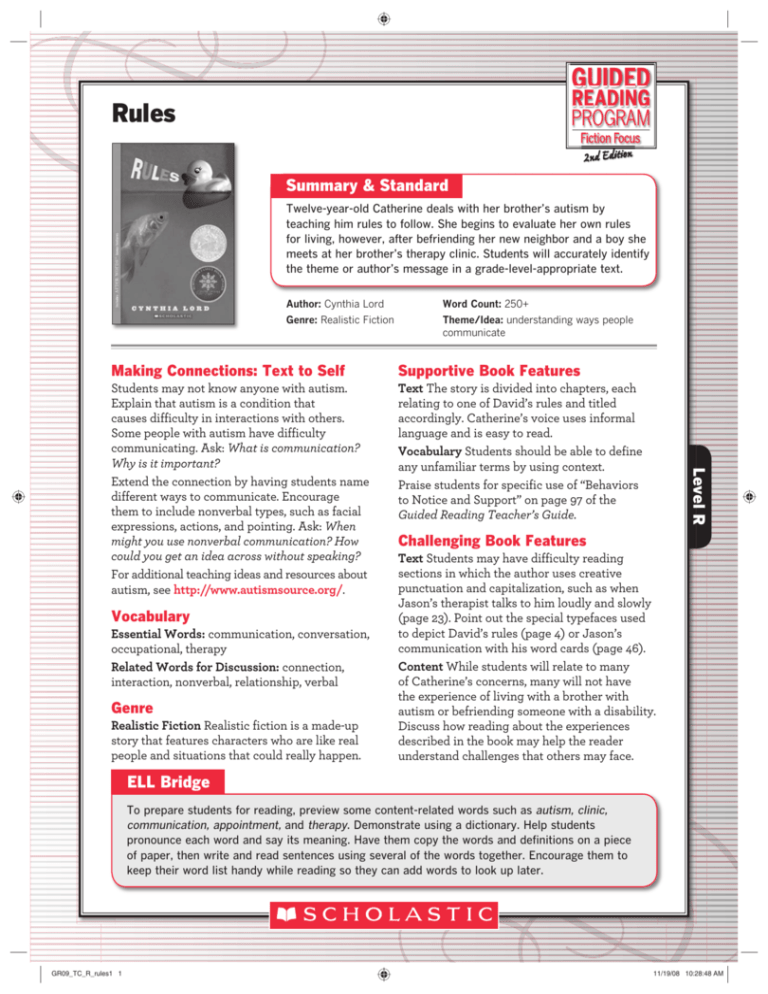
2@4/0/
=0,/492
;=:2=,8
Rules
1TN_TZY1ZN`^
2nd Edition
Summary & Standard
Twelve-year-old Catherine deals with her brother’s autism by
teaching him rules to follow. She begins to evaluate her own rules
for living, however, after befriending her new neighbor and a boy she
meets at her brother’s therapy clinic. Students will accurately identify
the theme or author’s message in a grade-level-appropriate text.
Author: Cynthia Lord
Word Count: 250+
Genre: Realistic Fiction
Theme/Idea: understanding ways people
communicate
Supportive Book Features
Students may not know anyone with autism.
Explain that autism is a condition that
causes difficulty in interactions with others.
Some people with autism have difficulty
communicating. Ask: What is communication?
Why is it important?
Extend the connection by having students name
different ways to communicate. Encourage
them to include nonverbal types, such as facial
expressions, actions, and pointing. Ask: When
might you use nonverbal communication? How
could you get an idea across without speaking?
For additional teaching ideas and resources about
autism, see http://www.autismsource.org/.
Text The story is divided into chapters, each
relating to one of David’s rules and titled
accordingly. Catherine’s voice uses informal
language and is easy to read.
Vocabulary Students should be able to define
any unfamiliar terms by using context.
Praise students for specific use of “Behaviors
to Notice and Support” on page 97 of the
Guided Reading Teacher’s Guide.
Vocabulary
Essential Words: communication, conversation,
occupational, therapy
Related Words for Discussion: connection,
interaction, nonverbal, relationship, verbal
Genre
Realistic Fiction Realistic fiction is a made-up
story that features characters who are like real
people and situations that could really happen.
Level R
Making Connections: Text to Self
Challenging Book Features
Text Students may have difficulty reading
sections in which the author uses creative
punctuation and capitalization, such as when
Jason’s therapist talks to him loudly and slowly
(page 23). Point out the special typefaces used
to depict David’s rules (page 4) or Jason’s
communication with his word cards (page 46).
Content While students will relate to many
of Catherine’s concerns, many will not have
the experience of living with a brother with
autism or befriending someone with a disability.
Discuss how reading about the experiences
described in the book may help the reader
understand challenges that others may face.
ELL Bridge
To prepare students for reading, preview some content-related words such as autism, clinic,
communication, appointment, and therapy. Demonstrate using a dictionary. Help students
pronounce each word and say its meaning. Have them copy the words and definitions on a piece
of paper, then write and read sentences using several of the words together. Encourage them to
keep their word list handy while reading so they can add words to look up later.
GR09_TC_R_rules1 1
11/19/08 10:28:48 AM
Developing Comprehension
Thinking Within the Text
Have students trace how Catherine’s
relationships with Jason, Kristi, and David
develop over the course of the book. Ask
them to cite specific evidence from the text.
Thinking Beyond the Text
Remind students that one of Catherine’s
rules is Some people think they know who you
are, when really they don’t. Ask students what
they think she means. Ask: Do you agree
with Catherine? Why or why not? Point out
that one important way people get to know
who you are is through communication. Ask
students how people can communicate to
others who they really are.
Thinking About the Text
Ask students to identify different methods
the author uses to convey how people (and
guinea pigs) communicate in this book.
For example, Catherine’s thoughts and the
thoughts she imagines her guinea pigs have
are in italics, and Jason’s dialogue is set in a
different font and conveyed through different
combinations of card text. The things Jason’s
therapist says to him are set in parentheses
and all caps to depict that she is shouting
and gesturing.
Making Predictions
Explain to students that they can often predict
what will happen next in a story by paying
attention to foreshadowing, or clues the author
gives about future events. For example, the
reader may be able to guess how Jason feels
about Catherine because he changes his shirt
(page 67) and gets his hair cut (page 114).
Ask students to identify other examples of
foreshadowing in this book, such as Catherine’s
lying about inviting the neighbors to the
cookout (page 65), foreshadowing the fact that
she tries to hide David’s problems from them.
For more prompts and ideas for teaching
problem-solving strategies, see page 22 of the
Guided Reading Teacher’s Guide.
TM & © Scholastic Inc. RULES by Cynthia Lord. Copyright © 2006 by Cynthia Lord. Published by Scholastic Inc. All rights reserved. Cover: (t) Gary Doak/Photonica; (b) G.K. and Vikki Hart/Iconica.
Teaching Options
Developing Phonics and
Word-Solving Strategies
Personification
Remind students that personification is a
figure of speech that gives an idea or object the
characteristics of a person.
• Point out that Catherine often personifies
letters and words. For example, she says
‘why not’ is pushier—like ‘why’ with a fist
on its hip (page 76), and on page 158 she
personifies each letter of the word dance.
• Ask students to identify other examples of
personification as they read.
Developing Fluency
Model reading page 53, using punctuation for
proper phrasing and emphasizing text within
quotation marks. Then invite groups to take
turns rereading the section aloud.
Oral Language/Conversation
Talk About Communication Point out that
communication is one way human beings
connect with each other. Have students discuss
forms of communication mentioned in this
book, such as Jason’s communication book,
flashlight Morse Code, jokes, sticky notes,
music, rules, facial expressions, drawings, and
giving gifts. List additional forms, such as sign
language, books, and mass media.
Extending Meaning Through Writing
• Have students describe the top five
words or phrases they would want in a
“communication book” and explain why
they chose these particular words and/or
phrases. (Expository)
• Have students write a scene describing
Catherine’s and Kristi’s next meeting that
reveals where their friendship stands.
(Narrative)
Other Books
Against the Odds by Joe Layden
Oh, Brother by Johnniece Marshall Wilson
GRFF2R07
GR09_TC_R_rules2 2
11/19/08 10:29:11 AM

